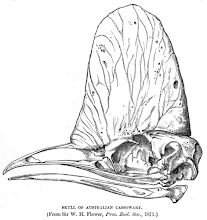coloration is one of the most appealing aspects about the avian clade. for example, the parrot's colors are what makes it one of the most charismatic birds in the animal kingdom. well, that and the whole talking thing.

one might say that coloration a hue-ge aspect in the daily lives of birds.[oh gee, i wish i was a shade better at pun-making.]
colors are expressed in the feather of the bird, rather than in the skin, as in humans. that is why if you see a bird without feathers, it will be effectively colorless. i know, you probably don't see a lot of featherless birds. well, you're in luck! here's this:
different colors are produced by different means, and the way they are expressed depends on these means. i think i'll start out with talking about a pigment we all know and love, melanin:
melanin is a really common pigment found in all types of animals, including humans! it's what is responsible for browns, deep purples, grays, and blacks. melanins, though they are kind of boring looking, have a bonus effect: they strengthen the substrate they are embedded in, which reinforces structure! for example, the hair in bears is really wiry and thick due in part to melanin.

wow, bears are weird looking.
incidentally, an inability to produce the melanin pigment results in albinism.

melanin explains brown, but let's be honest here, brown should be called BORE-own, am i right? whattabout the fun colors like ........Oranges Yellows and Reds? Blues? Greens?
i'll be addressing them in that order.
oranges, yellows, and some reds are produced by nifty pigments called carotenoids. carotenoids were first discovered in...carrots! [botanists are some of the most apt namers in the biz. --oh, you found a compound in a carrot? call it a carotenoid!]
carotenoids are found in a lot of fruits and vegetables, and interestingly enough cannot be synthesized by birds. thus, in order to express these pigments, they must be ingested.

this is a really really really really close look at a group of red pepper cells. the red dots are called chromoplasts, which are organelles that synthesize and house carotenoids.
flamingos are pink because of the carotenoids in their diet of shrimp and red algae. this dead one is not pink because it hasn't been eating carotenoid containing food for a while. i don't think it's been doing much of anything else, either.

tough break!
blues are my favorite type of coloring in birds. the thing about blue is, it isn't really a pigment. instead, blue is emitted from a feather due to the structure of the feather itself.
what happens is light [usually white] hits the surface of the feather, whose surface physical properties are altered in such a manner that they reflect blue light waves. this principle is also used in human technologies, cool!


blue jays and indigo buntings, both native to iowa, are good examples of the rich blues that can be found in feathers.


bright greens occur when a feather has both carotenoids and physical structure that allows the feather to emit blue. these two properties work in tandem, et voila, on a des plumes vertes.

wow, what a picture! people who own birds are such oddballs.
the exciting coloration found across bird species is generally limited to the males, which seems like kind of a rip for the females. i mean, comon, look at the wood duck drake vs. the wood duck hen:

the brown boring ones are females.
though it may seem like a total rip for the female, the reason behind the disparity in flamboyant coloration in males and pretty drab colors in females is called sexual dimorphism, and can be attributed to a phenomenon known as sexual selection.
females run the show when it comes to makin' babies. generally speaking, it is the females who house the eggs in their body, lay the eggs, and then raise their progeny. the whole point of having babies is to further propagate the species, and the best way to do this is to make sure the babies survive to adulthood, where they in turn will go on propagating the species. birds cannot analyze genotype (all the genes an organism has), and so must base their decision for a mate on phenotype (what genes are expressed, or what the organism looks like physically). essentially, the females are going to select the best looking dude available.
because the males who look the best are the ones passing on their DNA, the male offspring will probably look just as good. as time progresses, females are essentially choosing mates from the creme de la creme, and as a result, we get REALLY COOL LOOKIN' birds.
